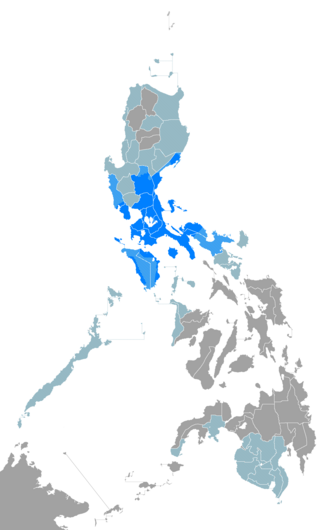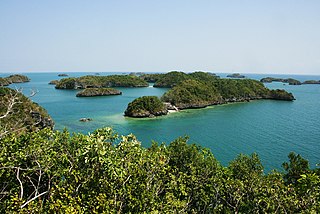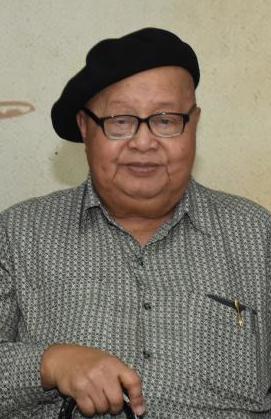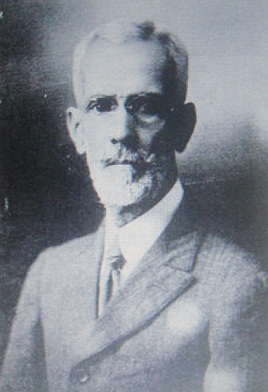
Tagalog is an Austronesian language spoken as a first language by the ethnic Tagalog people, who make up a quarter of the population of the Philippines, and as a second language by the majority. Its standardized form, officially named Filipino, is the national language of the Philippines, and is one of two official languages, alongside English.

Luzon is the largest and most populous island in the Philippines. Located in the northern portion of the Philippines archipelago, it is the economic and political center of the nation, being home to the country's capital city, Manila, as well as Quezon City, the country's most populous city. With a population of 64 million as of 2021, it contains 52.5% of the country's total population and is the fourth most populous island in the world. It is the 15th largest island in the world by land area.

Filipino is a language under the Austronesian language family. It is the national language of the Philippines, and one of the two official languages of the country, with English. It is a standardized variety of Tagalog based on the native dialect, spoken and written, in Metro Manila, the National Capital Region, and in other urban centers of the archipelago. The 1987 Constitution mandates that Filipino be further enriched and developed by the other languages of the Philippines. Filipino is only used as a tertiary language in the Philippine public sphere.
Baybayin is a Philippine script. The script is an abugida belonging to the family of the Brahmic scripts. Geographically, it was widely used in Luzon and other parts of the Philippines prior to and during the 16th and 17th centuries before being replaced by the Latin alphabet during the period of Spanish colonization. It was used in the Tagalog language and, to a lesser extent, Kapampangan-speaking areas; its use spread to the Ilocanos in the early 17th century. In the 19th and 20th centuries, baybayin survived and evolved into multiple forms—the Tagbanwa script of Palawan, and the Hanuno'o and Buhid scripts of Mindoro—and was used to create the constructed modern Kulitan script of the Kapampangan and the Ibalnan script of the Palawan people. Under the Unicode Standard and ISO 15924, the script is encoded as the Tagalog block.

Pangasinan (Pangasinense) is an Austronesian language, and one of the eight major languages of the Philippines. It is the primary and predominant language of the entire province of Pangasinan and northern Tarlac, on the northern part of Luzon's central plains geographic region, most of whom belong to the Pangasinan ethnic group. Pangasinan is also spoken in southwestern La Union, as well as in the municipalities of Benguet, Nueva Vizcaya, Nueva Ecija, and Zambales that border Pangasinan. A few Aeta groups in Central Luzon's northern part also understand and even speak Pangasinan as well.

The Laguna copperplate inscription is an official acquittance inscribed onto a copper plate in the Shaka year 822. It is the earliest known calendar-dated document found within the Philippine Islands.

Pangasinan, officially the Province of Pangasinan, is a coastal province in the Philippines located in the Ilocos Region of Luzon. Its capital is Lingayen. Pangasinan is in the western area of Luzon along the Lingayen Gulf and the South China Sea. It has a total land area of 5,451.01 square kilometres (2,104.65 sq mi). According to the 2020 census it has a population of 3,163,190. The official number of registered voters in Pangasinan is 1,651,814. The western portion of the province is part of the homeland of the Sambal people, while the central and eastern portions are the homeland of the Pangasinan people. Due to ethnic migration, the Ilocano people settled in the province.

Francisco Sionil José was a Filipino writer who was one of the most widely read in the English language. A National Artist of the Philippines for Literature, which was bestowed upon him in 2001, José's novels and short stories depict the social underpinnings of class struggles and colonialism in Filipino society. His works—written in English—have been translated into 28 languages, including Korean, Indonesian, Czech, Russian, Latvian, Ukrainian and Dutch. He was often considered the leading Filipino candidate for the Nobel Prize in Literature.

Recent archaeological and other evidence suggests Hinduism has had some cultural, economic, political and religious influence in the Philippines. Among these is the 9th century Laguna Copperplate Inscription found in 1989, deciphered in 1992 to be Kawi script with Sanskrit words; the golden Agusan statue discovered in another part of Philippines in 1917 has also been linked to Hinduism.
Josephine Acosta Pasricha is a Filipino indologist who translated the "Ramacharitamanasa" of Tulasi Dasa, the Hindi translation of the Ramayana by Valmiki in Sanskrit, into the Filipino language.

Biag ni Lam-ang is an epic story of the Ilocano people from the Ilocos region of the Philippines. It is notable for being the first Philippine folk epic to be recorded in written form, and was one of only two folk epics documented during the Philippines' Spanish Colonial period, along with the Bicolano epic of Handiong. It is also noted for being a folk epic from a "Christianized" lowland people group, with elements incorporated into the storytelling.

Bienvenido Lumbera was a Filipino poet, critic and dramatist. Lumbera is known for his nationalist writing and for his leading role in the Filipinization movement in Philippine literature in the 1960s, which resulted in his being one of the many writers and academics jailed during Ferdinand Marcos' Martial Law regime. He received the Ramon Magsaysay Award for Journalism, Literature and Creative Communications in 1993, and was proclaimed a National Artist of the Philippines for literature in 2006. As an academic, he is recognized for his key role in elevating the field of study which would become known as Philippine Studies.
Buddhism is a minor religion in the Philippines. In 2016, Buddhism was practiced by around 2% of the population, according to the Permanent Mission of the Republic of the Philippines to the United Nations.
The nature of religion in the pre-colonial Philippines is often unclear. Religions present include animism, indigenous religious beliefs and mythologies such as Anito and influences from Hinduism and Buddhism. The earliest pieces of evidence that exist are archaeological finds including Hindu–Buddhist gold statues. The earliest written evidence comes from the Laguna Copperplate Inscription, dated to around 900 CE, which uses the Buddhist–Hindu lunar calendar. With the arrival of Islam in the 14th century, the older religions gradually disappeared, and after the arrival of Ferdinand Magellan in 1521 Christianity, specifically Roman Catholicism, became the dominant religion. However, some of the indigenous peoples of the Philippines continue to practice animism today, and many of the traditions in Anito have survived in the form of Folk Catholicism.

Trinidad Hermenegildo José María Juan Francisco Pardo de Tavera y Gorricho was a Filipino physician, historian and politician of Spanish and Portuguese descent who served as Deputy Prime Minister of the Philippines in 1899.

India–Philippines relations, also knows as Indian-Filipino relations or Indo-Filipino relations, are the bilateral relations between the India and the Philippines. Diplomatic relations between India and the Philippines was established in 1949. India maintains an embassy in Manila, whilst the Philippines maintains one in New Delhi. A Treaty of Friendship was signed between the Philippines and India on 11 July 1952.
The Indian influences in early Philippine polities, particularly the influence of the Srivijaya and Majapahit thalassocracies on cultural development, is a significant area of research for scholars of Philippine, Indonesian, and Southeast Asian history, and is believed to be the source of Hindu and Buddhist elements in early Philippine culture, religion, and language. Because the Indonesian thalassocracies of Srivijaya and Majapahit acquired many of these Hindu and Buddhist elements through Indianization, the introduction of such elements to early Philippine cultures has sometimes been referred to as indianization. In more recent scholarship, it is termed localization, as in, e.g., localization of Hindu and Buddhist beliefs. Some scholars also place the Philippine archipelago within the outermost reaches of the Indosphere, along with Northern Vietnam, where the Hindu and Buddhist elements were not directly introduced by Indian travellers.
The Maharadia Lawana is a Maranao epic which tells a local version of the Indian epic Ramayana. Its English translation is attributed to Filipino Indologist Juan R. Francisco, assisted by Maranao scholar Nagasura Madale, based on Francisco's ethnographic research in the Lake Lanao area in the late 1960s.

The historiography of the Philippines includes historical and archival research and writing on the history of the Philippine archipelago including the islands of Luzon, Visayas, and Mindanao.Mref=SebastianUndated>Sebastian, Raul Roland R. "Philippine Historiography: Issues and Trends"(PDF). Polytechnic University of the Philippines. Archived from the original(PDF) on October 1, 2019.</ref>











